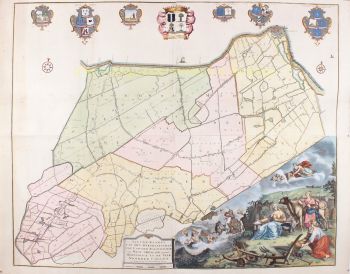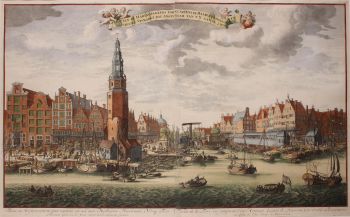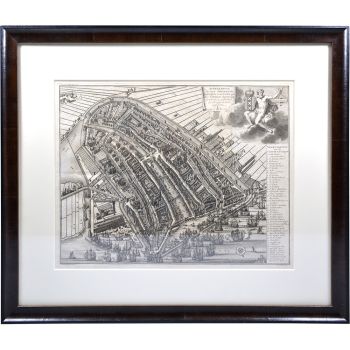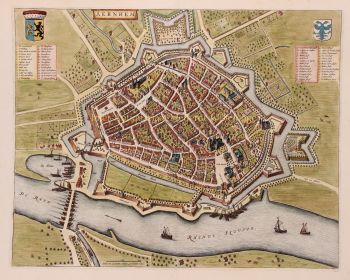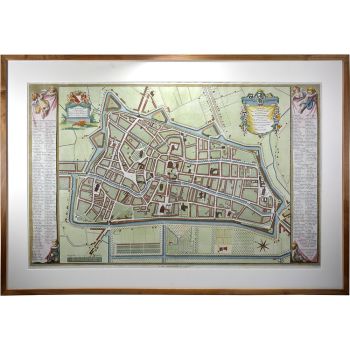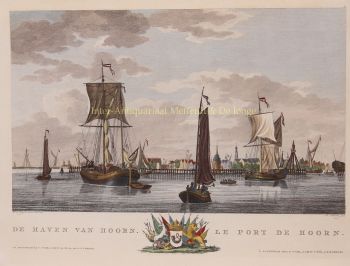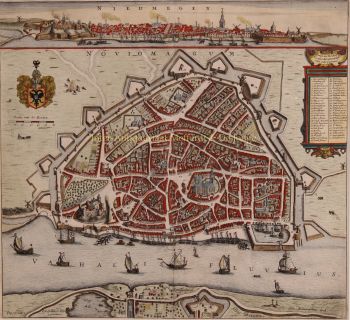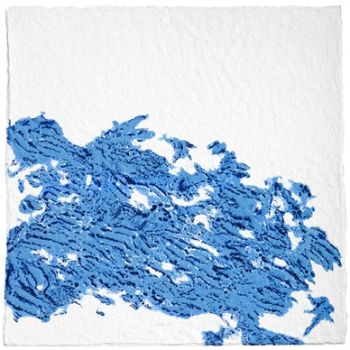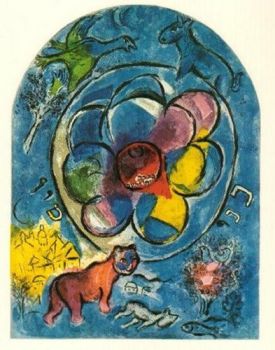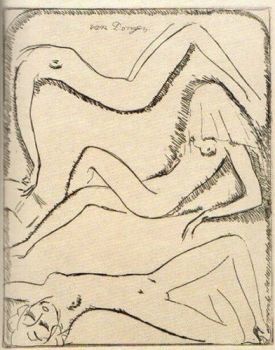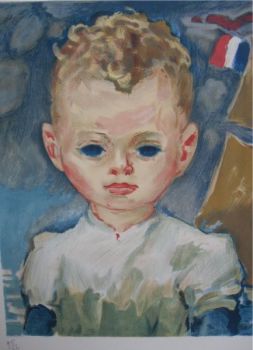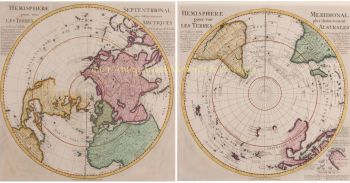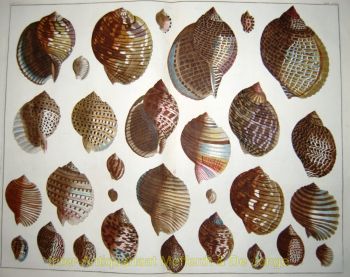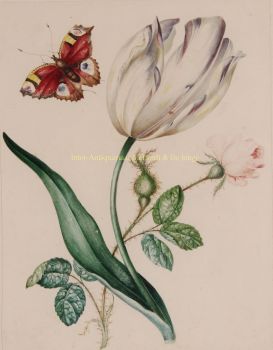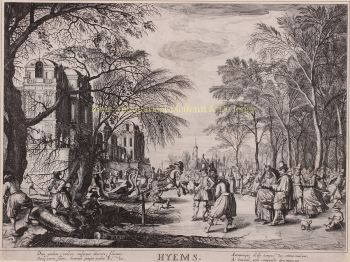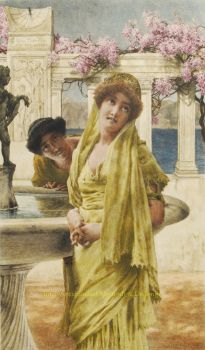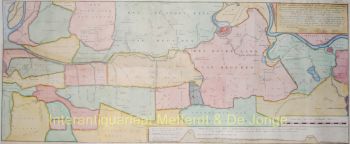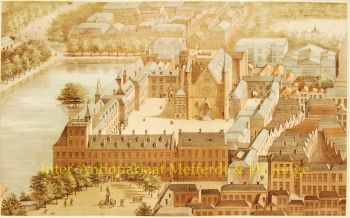Amsterdam 1783
Hendrik Leth
€ 2.250
Inter-Antiquariaat Mefferdt & De Jonge
- A proposito di opere d'arte
PLAN TRES EXACT DE LA VILLE FAMEUSE MARCHANDE D'AMSTERDAM. Copper engraving printed on two sheets by Hendrik de Leth, published 1783. Measures 57.5 x 88 cm. On 24 and 27 April 1734, the following advertisement appeared in the Amsterdamsche Courant: "Te Amsterd. By Hend. De Leth on the Beurssluys, is now published, an entirely new and accurate Plan of the city of Amsterdam, with many additions that were not found in any previous plans; decorated on both sides with the coats of arms of the Wel-Ed. en Groot Agtb. Heeren Burgemeesteren deezer stad, zedert de Reformatie tot nu, door voorname Liefhebbers keurig nagezien". One could choose between a rich version with family coats of arms and the coats of arms of the Amsterdam mayors on both sides, and a plain version without the coats of arms. This copy is the version without the coats of arms. Hendrik de Leth had made a reliable map amidst many competitors (such as Covens & Mortier), which was very useful in the city administration. The dignified French title seems destined for a more representative function, but for the rest the print is entirely in Dutch, which was convenient for the artisans and administrative users. Under the title we read "Gravée et mis au jour Par Henry de Leth a l'enseigne du Pecheur". This can be translated as "Engraved and updated to the present day by Hendrik de Leth under the label of Visser." The shop of publisher Nicolaes Visscher II kept this name, even after his death in 1702. Hendrik de Leth and also his father Andries worked in Visscher's shop when he was still alive. After Visscher's death his widow Elisabeth Verseyl continued the business until 1726. From about 1720, however, the daily management was in the hands of Andries. After he took over the business, he maintained the shop's well-known name. After his death in 1731, Hendrik, the son of Andries, took over. He too continued with the same shop name. The map is extremely clear and uncluttered, with only the main buildings standing out. Hendrik de Leth made the map after an older example and provided it with completely new decoration. An interesting difference between the map by De Leth and the earlier one is that De Leth gave the buildings engraved in the uprising a shadow. The sunlight here comes from the left, which corresponds to the eastern morning sun. To the left of the decorative, opening curtain, we see a Caarte van Amstelland. It is striking that in the legend block in the top right-hand corner, an I is mentioned after nine buildings. The legend explains this with the words NB Daar een I bystaat betekent Jansenisten. Jansenism, named after Cornelis Jansenius (1585-1638), was a religious and political movement from the seventeenth and eighteenth centuries that developed mainly in France as a reaction to certain developments in the Catholic Church and to the absolutism of the rulers of those days. The Jansenists' way of life was characterised by their ascetic rejection of the world and their pessimistic ethics. They also rejected, among other things, papal infallibility. The accentuation of the buildings on the map that had a relationship with Jansenism suggests that the engraver and publisher Hendrik de Leth adhered to this political movement. The central representation under the map is designed with care and taste. The title plate is beautifully incorporated into a group of figures, in which the city virgin is flanked by the two lions of the city arms and the river gods of Amstel and IJ, while Fortuna rises from the sea. The compass rose and ruler, like the title, have been given a three-dimensional shape as part of this grouping. The city seal and coat of arms above the map are carried by two angels. Literature: Marc Hameleers - Maps of Amsterdam 1538-1865, nr. 114 p.228-231 Price: Euro 2.250
- A proposito di opere artista
Hendrik de Leth (Amsterdam, 31 maggio 1703 – Amsterdam, 17 giugno 1766) è stato un artista della stampa, incisore, incisore, cartografo, disegnatore, libraio, mercante d'arte, editore di stampe, collezionista d'arte e collezionista di naturalia.
Hendrik de Leth era figlio di Andries de Leth (tagliapiatti, libraio, 1662-1731) e Nelletje Middenheespen. Hendrik aveva un fratello maggiore, Christiaan de Leth. Nel 1742 Hendrik sposò Sophia Otto, che morì nel 1753. Il loro matrimonio rimase senza figli. Era probabile che il nipote Andries, figlio del fratello di Hendrik, Christiaan, sarebbe diventato il successore dell'attività di Hendrik. Tuttavia, morì nel 1743. Nel 1766 Hendrik de Leth fece redigere un testamento poco prima della sua morte, in base al quale Catharina le Blanc, nipote del fratello Christiaan, divenne erede. Il 30 settembre 1766 ebbe luogo l'asta dei suoi beni.[3]
Nel 1728 Hendrik si unì alla corporazione dei librai. Prima di allora era uno studente di suo padre Andries de Leth, che aveva rilevato la mappa, la stampa e il mercante d'arte "Op de Beurssluys, in den Visscher" ad Amsterdam dal cartografo e incisore Nicolaas Visscher II. Hendrik de Leth a sua volta rilevò questa azienda dopo la morte del padre nel 1731.
Già nel 1725 fu pubblicata l'opera Images of the Wijdtvermaarde city of Amsterdam oltre ai suoi più importanti Buildings and Gesites, tutti accuratamente disegnati dopo la vita e pubblicati ad Amsterdam.
La sua opera più nota con 100 stampe fu pubblicata nel 1730: Lo splendore benedicente Kennemerlant : mostra molti volti gloriosi dei luoghi di piacere più importanti di quest'ultimo, case nobiliari, edifici di villaggi e città : a partire da Kastrikum (...) / disegnato dopo la vita e nel rame portato da H. de Leth; e brevemente descritto da M. Brouërius van Nidek. - Amsterdam : De Leth, 1730. Molte stampe che De Leth fece di Amsterdam si trovano negli archivi della città di Amsterdam.
Come cartografo, De Leth era meglio conosciuto per il suo New Geographical Atlas e Historical Atlas, Van de Zeven Vereenigde Nederlandsche Provintien, pubblicato nel 1740. De Leth divenne noto anche per le incisioni su rame che fece intorno al 1758 della Mappa Generale della Colonia o Provincia del Suriname su disegno di Alexander de Lavaux.
Sei interessato ad acquistare questa opera d'arte?
Artwork details
Related artworks
- 1 - 3 / 3
- 1 - 4 / 24
- 1 - 4 / 12



